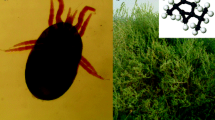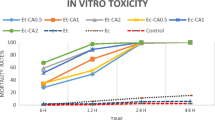Abstract
Resistance to conventional synthetic pesticides has been widely reported in Dermanyssus gallinae in poultry production systems. Introducing novel acaricides to poultry industry today is more urgent than ever. Research in this field recently focused on plants and plant-derived compounds as acaricides. In the present study, acaricidal activity of three plant bioactive components, carvacrol, thymol, and farnesol, was assessed against D. gallinae and compared with synthetic pesticide permethrin. Mode of acaricidal action was determined by contact toxicity and fumigant toxicity bioassays. Except farnesol which did not cause any mortality, carvacrol and thymol were found to be toxic to D. gallinae with LD50 values of 1 and 3.15 μg/cm3, respectively. Permethrin gave the LD50 value of 31.95 μg/cm3 which was less efficient than carvacrol and thymol. In fumigant toxicity bioassay, mortality rate in carvacrol- and thymol-treated groups in closed method was significantly higher than the open one. On the other hand, permethrin exhibited poor fumigant toxicity as there was no statistically significant difference between mortality rate in open and closed methods. These findings revealed that mechanism of acaricidal activity of carvacrol and thymol but not permethrin was mainly due to fumigant action. Results of the present study suggested that carvacrol and thymol, especially carvacrol, can be developed as a novel potent bioacaricide against D. gallinae.


Similar content being viewed by others
References
Abdel-Ghaffar F, Sobhy MH, Al-Quraishy S, Semmler M (2008) Field study on the efficacy of an extract of neem seed (Mite -Stop®) against the red mite Dermanyssus gallinae naturally infecting poultry in Egypt. Parasitol Res 103:481–485
Abdel-Ghaffar F, Semmler M, Al-Rasheid K, Mehlhorn H (2009) In vitro efficacy of ByeMite® and Mite-Stop® on developmental stages of the red chicken mite Dermanyssus gallinae. Parasitol Res 105:1469–1471
Ahn YJ, Lee SB, Lee HS, Kim GH (1998) Insecticidal and Acaricidal Activity of Carvacrol and β-Thujaplicine Derived from Thujopsis dolabrata var. hondai Sawdust. J Chem Ecol 24:81–90
Archana PR, Nageshwar Rao B, Satish Rao BS (2011) Modulation of gamma ray-induced genotoxic effect by thymol, a monoterpene phenol derivative of cymene. Integr Cancer Ther 10:374–383
Beugnet F, Chauve C, Gauthey M, Beert L (1997) Resistance of the red poultry mite to pyrethroids in France. Vet Rec 140:577–79
Chauve C (1998) The poultry red mite Dermanyssus gallinae (De Geer, 1778): current situation and future prospects for control. Vet Parasitol 79:39–45
Chikuba T, Itou H, Sakakibara H, Inoue D (2008) Detection of fowl pox virus from red mite (Dermanyssus gallinae) at a layer farm occurring cutaneous fowlpox. J Jpn Soc Poult Dis 44:113–117
Chirico J, Eriksson H, Fossum O, Jansson D (2003) The poultry red mite, Dermanyssus gallinae, a potential vector of Erysipelothrix rhusiopathiae causing erysipelas in hens. Med Vet Entomol 17:232–234
Cimanga K, Kambu K, Tona L, Apers S, De Bruyne T, Hermans N, Totté J, Pieters L, Vlietinck AJ (2002) Correlation between chemical composition and antibacterial activity of essential oils of some aromatic medicinal plants growing in the Democratic Republic of Congo. J Ethnopharmacol 79:213–220
Faghihzadeh Gorji S, Faghihzadeh Gorji S, Rajabloo M (2014) The field efficacy of garlic extract against Dermanyssus gallinae in layer farms of Babol, Iran. Parasitol Res 113:1209–13
Fiddes MD, Le Gresley S, Parsons DG, Epe C, Coles GC, Stafford KA (2005) Prevalence of the poultry red mite (Dermanyssus gallinae) in England. Vet Rec 157:233–235
George DR, Sparagano OAE, Port G, Okello E, Shiel RS, Guy JH (2009a) Environmental interactions with the toxicity of plant essential oils to the poultry red mite Dermanyssus gallinae. Med Vet Entomol 24:1–8
George DR, Smith TJ, Shiel RS, Sparagano OAE, Guy JH (2009b) Mode of action and variability in efficacy of plant essential oils showing toxicity against the poultry mred mite, Dermanyssus gallinae. Vet Parasitol 161:276–282
George DR, Biron JM, Jolly G, Duvallet G, Sparagano OAE (2009c) Toxicity of geraniol solution in vitro to the poultry red mite, Dermanyssus gallinae. Parasit 16:319–321
Hamidi A, Sherifi K, Muji S, Behluli B, Latifi F, Robaj A, Postoli R, Hess C, Hess M, Sparagano OAE (2011) Dermanyssus gallinae in layer farms in Kosovo: a high risk for Salmonella prevalence. Parasit Vectors 4:136
Hollis J (2009) Biopesticides registration action document. Farnesol Nerolidol
Horn TL, Long L, Cwik MJ, Morrissey RL, Kapetanovic IM, McCormick DL (2005) Modulation of hepatic and renal drug metabolizing enzyme activities in rats by subchronic administration of farnesol. Chem Biol Interact 152:79–99
Isman MB (2008) Botanical insecticides: for richer, for poorer. Pest Manag Sci 64:8–11
Jayakumar S, Madankumar A, Asokkumar S, Raghunandhakumar S, Gokula Dhas K, Kamaraj S, Divya MG, Devaki T (2012) Potential preventive effect of carvacrol against diethylnitrosamine-induced hepatocellular carcinoma in rats. Mol Cell Biochem 360:51–60
Jeong EY, Lim JH, Kim HG, Lee HS (2008) Acaricidal activity of Thymus vulgaris oil and its main components against Tyrophagus putrescentiae, a stored food mite. J Food Prot 71:351–5
Kilpinen O, Roepstorff A, Permin A, Norgaard-Nielsen G, Lawson LG, Simonsen HB (2005) Influence of Dermanyssus gallinae and Ascaridia galli infections on behaviour and health of laying hens (Gallus gallus domesticus). Br Poult Sci 46:26–34
Kim S, Yi J, Tak J, Ahn Y (2004) Acaricidal activity of plant essential oils against Dermanyssus gallinae (Acari: Dermanyssidae). Vet Parasitol 120:297–304
Kim S, Na YE, Yi JH, Kim BS, Ahn YJ (2007) Contact and fumigant toxicity of oriental medicinal plant extracts against Dermanyssus gallinae (Acari: Dermanyssidae). Vet Parasitol 145:377–382
Kirkwood AC (1968) Anemia in poultry infested with red mite Dermanyssus gallinae. Vet Rec 80:514–516
Kočišová A, Plachʹy J (2008) Novel approach to controlling the poultry red mite (Acarina: Mesostigmata).In Proc. Int. Conf. Urban Pests, 6th, Budapest. OOK-Press Kft, Hungary, pp 349–54, July 13–16
Locher N, Al-Rasheid Kh AS, Abdel-Ghaffar F, Mehlhorn H (2010) In vitro and field studies on the contact and fumigant toxicity of a neem-product (Mite-Stop®) against the developmental stages of the poultry red mite Dermanyssus gallinae. Parasitol Res 107:417–423
Miresmailli S, Bradbury R, Isman MB (2006) Comparative toxicity of Rosmarinus officinalis L. essential oil and blends of its major constituents against Tetranychus urticae Koch (Acari: Tetranychidae) on two different host plants. Pest Manag Sci 62:366–371
Nordenfors H, Höglund J, Tauson R, Chirico J (2001) Effects of permethrin impregnated plastic strips on Dermanyssus gallinae in loose housing systems for laying hens. Vet Parasitol 102:121–31
Rahbari S, Nabian S, Ronaghi H (2009) Haematophagus Mites in Poultry Farms of Iran. Iran J Arthropod Borne Dis 3:18–21
Regev S, Cone WW (1976) Evidence of gonodotropic effect of farnesol in the twospotted spider mite, Tetranychus urticae. Environ Entomol 5:517–519
Sparagano O, Pavlicevic A, Murano T, Camarda A, Sahibi H, Kilpinen O, Mul M, van Emous R, le Bouquin S, Hoel K, Cafiero MA (2009) Prevalence and key figures for the poultry red mite Dermanyssus gallinae infections in poultry farm systems. Exp Appl Acarol 48:3–10
Sparagano O, Khallaayoune K, Duvallet G, Nayak S, George D (2013) Comparing Terpenes from Plant Essential Oils as Pesticides for the Poultry Red Mite (Dermanyssus gallinae). Transbound Emerg Dis 60:150–153
US EPA (2004) Biopesticides—25b Minimum Risk Pesticides. http://www.epa.gov/oppbppd1/biopesticides/regtools/25b_list.htm
Wang FF, Wang M, Xu FR, Liang DM, Pan BL (2010) Survey of prevalence and control of ectoparasites in caged poultry in China. Vet Rec 167:934–37
Author information
Authors and Affiliations
Corresponding author
Rights and permissions
About this article
Cite this article
Tabari, M.A., Youssefi, M.R., Barimani, A. et al. Carvacrol as a potent natural acaricide against Dermanyssus gallinae . Parasitol Res 114, 3801–3806 (2015). https://doi.org/10.1007/s00436-015-4610-0
Received:
Accepted:
Published:
Issue Date:
DOI: https://doi.org/10.1007/s00436-015-4610-0




